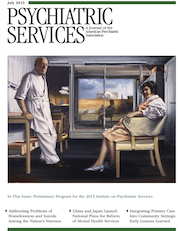Service Utilization for Mental Problems in a Metropolitan Migrant Population in China
Abstract
Objective
The purpose of this study was to investigate the prevalence and predictors of service utilization for mental health problems of the first-generation migrant population in Shenzhen, China, a city that attracts millions of unskilled rural laborers each year.
Methods
Using the structured World Mental Health Composite International Diagnostic Interview, the investigators conducted face-to-face surveys between September 1, 2005, and January 30, 2006. A total of 7,134 respondents age 18 years and above finished the surveys. The main outcomes were prevalence of mental disorders according to DSM-IV criteria, as well as prevalence of mental health services used in different sectors.
Results
Nine percent of the sample had ever used some type of service for mental health issues, and 6.3% used services outside of the health service sector, such as human services and complementary and alternative medicine. In addition, DSM criteria for a mental disorder over the lifetime were met by 18.1% of respondents; of the respondents with a mental disorder, 18.3% had used mental health services at least once. Migrants who were unmarried, had high family income, were raised in metropolitan areas, had histories of homelessness or attempted suicide, had a psychotic disorder, or had an anxiety disorder were more likely to use services for mental health care.
Conclusions
In Shenzhen, few migrants used mental health services and most used complementary and alternative medicine services. Future studies of service utilization patterns in migrant populations should give special attention to personal characteristics, such as family support.



